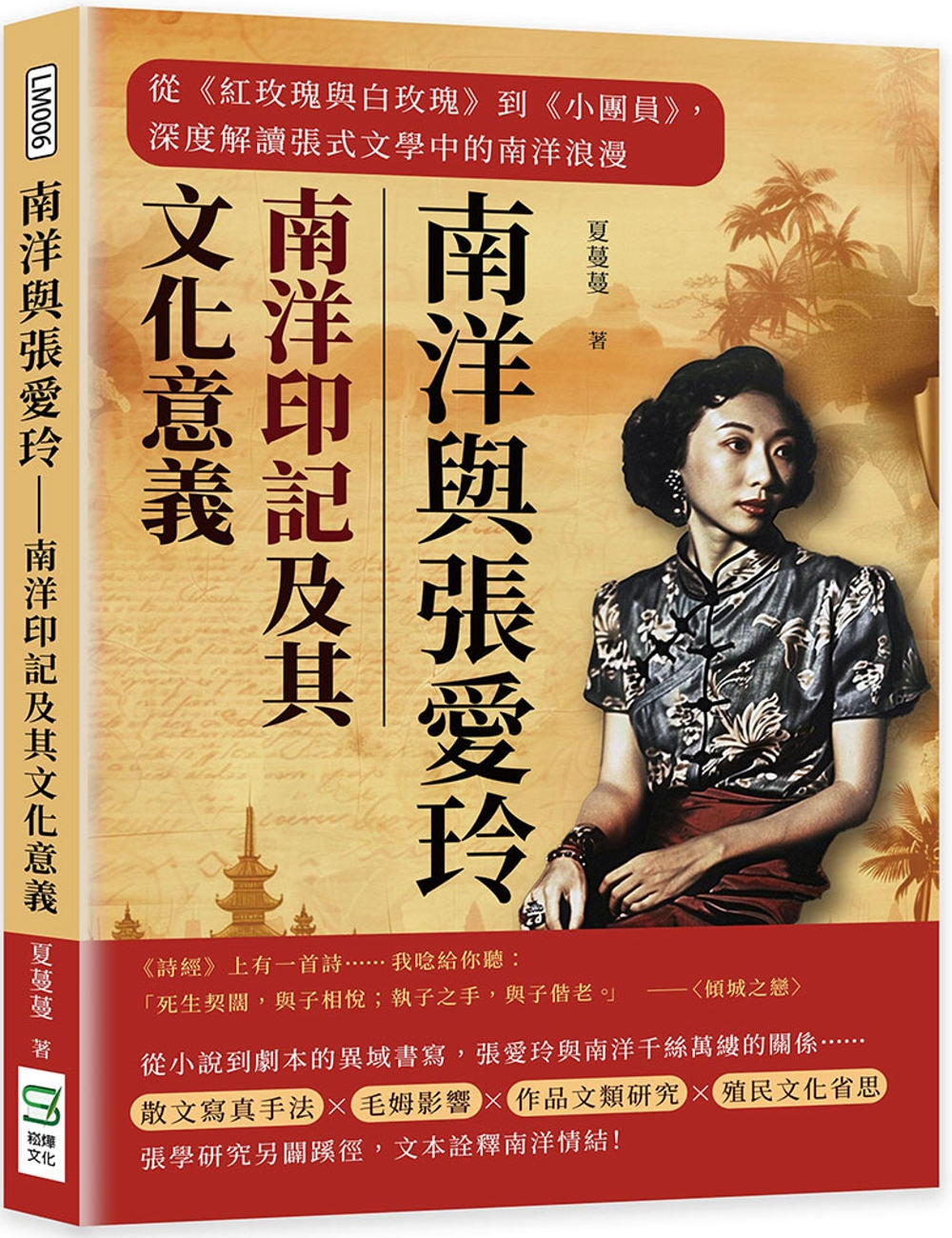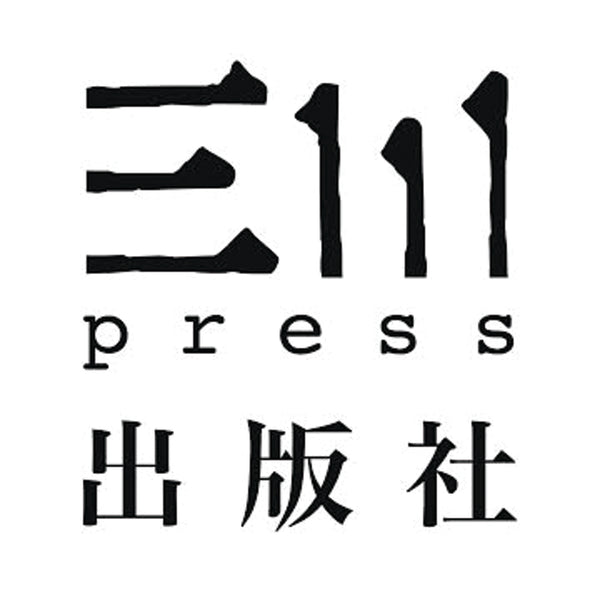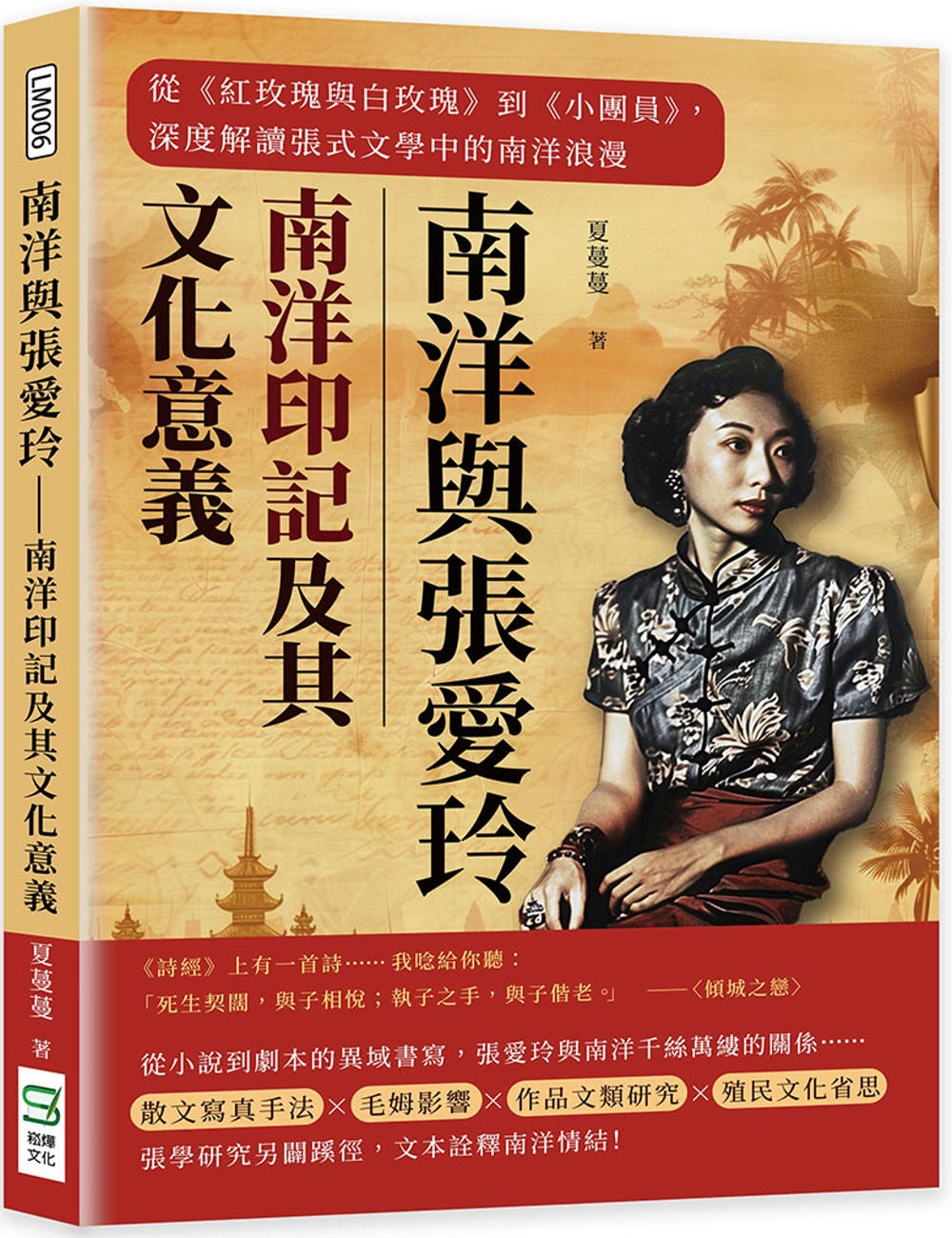Nanyang and Eileen Chang: Nanyang Imprint and Its Cultural Significance: From Red Rose and White Rose to Little League Member, an In-Depth Interpretation of Nanyang Romance in Zhang's Literature
Nanyang and Eileen Chang: Nanyang Imprint and Its Cultural Significance: From Red Rose and White Rose to Little League Member, an In-Depth Interpretation of Nanyang Romance in Zhang's Literature
In stock
Couldn't load pickup availability
ISBN/EAN: 9786263945197
出版日期: 2024-07-17
页数: 236页
语言: Traditional Chinese
There is a poem in the Book of Songs... I'll read it to you:
"Through life and death, I will be happy with you; I will hold your hand and grow old with you."
──《Love in a Fallen City》
From novels to screenplays, Eileen Chang's exotic writings reveal her inextricable connection with Southeast Asia...
Prose portraiture × Maugham's influence × Genre research × Reflections on colonial culture
Zhang Xue's research takes a new approach, with texts interpreting the Nanyang complex!
Exploring Eileen Chang's Nanyang Writings: "Nanyang and Eileen Chang" is a monograph that meticulously explores the Nanyang elements in Eileen Chang's literary works. Drawing on four perspectives, including novels, essays, film scripts, and autobiographical fiction, the book offers an in-depth analysis of the Nanyang characters, customs, and cultural symbols that appear in her works. Beginning in Chapter 1, the author, through meticulous textual analysis, demonstrates how Eileen Chang portrays the image of overseas Chinese in Nanyang in her novels, arguing that these depictions not only enrich the world of her work but also reveal her deep interest in foreign cultures. The essay section reveals Eileen Chang's realistic portrayal of Nanyang and explores the cultural characteristics of Nanyang reflected in her works.
Chapter 2 focuses on Chang Ailing's Nanyang sentiments in her essays, showcasing her use of a photorealistic approach to depict the region. Chapter 3 then turns to film scripts, analyzing the Nanyang elements Chang incorporated into her filmography. In particular, the Singapore setting of "Love Like a Battlefield" not only showcases her meticulous observations of Nanyang but also reflects her innovative and experimental spirit in filmmaking. These visual depictions allow readers to visually understand Chang Ailing's Nanyang sentiments and appreciate her in-depth exploration of Nanyang culture.
Chapter 4 focuses on Eileen Chang's autobiographical novel, Little Reunion, analyzing the Nanyang complex within her work. The book explores how Eileen Chang depicts Nanyang characters and settings in this highly autobiographical novel, arguing that these depictions are crucial for understanding her creative motivations and inner world. The author pays particular attention to Eileen Chang's portrayal of her mother, demonstrating how she uses this figure to express her emotional connection to and cultural identification with Nanyang.
Chapters 5 and 6 explore Zhang Ailing's Nanyang writings from a theoretical perspective. The author identifies three primary motivations for her Nanyang writings: Freudian theory, Bowlby and Ainsworth theory, and the influence of Maugham on Zhang Ailing. He then details how these theories explain Zhang's emotional attachment to Nanyang and her creative inspiration. Finally, in Chapter 6, the author summarizes the historical and cultural significance of Zhang Ailing's Nanyang writings, discusses the significant position of her works in Chinese literary history, and explores their connections to realism and postcolonialism. The entire book showcases the rich connotations and profound significance of Zhang Ailing's Nanyang writings, providing readers with a fresh understanding and appreciation of this literary master's writings about foreign lands.
Highlights of This Book <br />This book deeply explores the Nanyang elements in Eileen Chang's literary works, analyzing her Nanyang obsession through novels, essays, film scripts, and autobiographical novels. Through Eileen Chang's delicate depictions of Nanyang people and their customs, this book explores the inner emotions that led her to frequently be drawn to the region despite never having set foot there. Incorporating Freudian theory, the theories of Bowlby and Ainsworth, and the influence of Somerset Maugham, this book analyzes the psychological motivations behind her writing, offering readers a fresh understanding of Eileen Chang's writing about foreign lands.
Xia Manman
Liang Xiuhong, born Liang Xiuhong, is a native of Malacca. She now lives in Singapore. Her ancestral home is Xinghua Putian, the hometown of Concubine Mei. She graduated from Lincoln's Inn in London and holds a Master's degree in Chinese Language and Literature from Nanjing University. She was once the editor-in-chief of a famous legal journal. She has won the first prize in literature. Her works are often published in academic journals and newspapers. Some of her works are collected in "Returning Geese: A Selection of Southeast Asian Chinese Women Writers", "ASEAN Anthology", and "A Journey". When she is at home, she finds writing poetry as her life's joy.
Preface
Chapter 1: Novels: Overseas Chinese in Southeast Asia During the Yellow Plum Rain <br />Brushstroke Genesis: An Introduction to Zhang Ailing's Novels with Southeast Asian Flavors "Nanyang Writing" in Zhang Ailing's Novels
Special distinctions between branches of overseas Chinese society in Southeast Asia
Chapter 2: Eileen Chang’s Essays: Hong Kong and Nanyang’s Excellence <br />Eileen Chang’s Essays: The Photographic Techniques of Nanyang Writing
Emerald jadeite on the phoenix crown
Chapter 3 Film Scripts: Zhang Ailing’s “Nanyang Filmmaker”
Please welcome screenwriter Zhang...
"Nanyang Writing" in Zhang Ailing's Film Scripts
Leading role: Nanyang people
Chapter 4 1941 "Little Reunion": Eternal sweetness and warmth in the midst of mischievous disputes "Little Reunion": Legend and genre "Little Reunion" current research dilemma Characters overseas Chinese, overseas Chinese characters Mother: beautiful young women living in Southeast Asia Excluding Hu Lancheng: the multiplication of love worlds in "Little Reunion"
Chapter 5 Theory: Three Motivations for Zhang Ailing’s “Nanyang Writings” <br />How to interpret Zhang Ailing’s Nanyang sentiments Motivation 1: Freud’s theory Motivation 2: Bowlby and Ainsworth’s theory Motivation 3: The influence of “Nanyang Master” Maugham
Chapter 6 "Intellectuals" Eileen Chang <br />The historical and cultural value and significance of Eileen Chang's "Nanyang Writings" Historical value and significance Cultural value and significance Reflection on the transformation of semi-colonial/colonial culture Summary References Original English original translated works
Share


